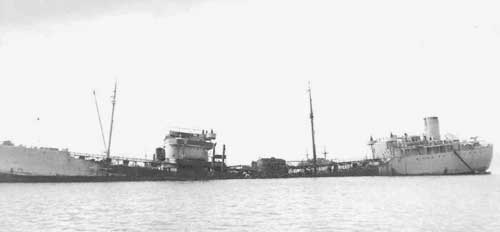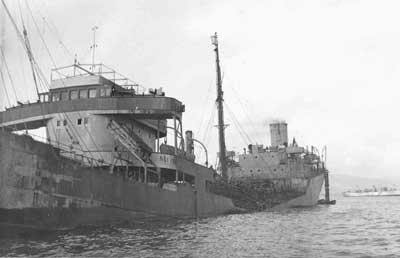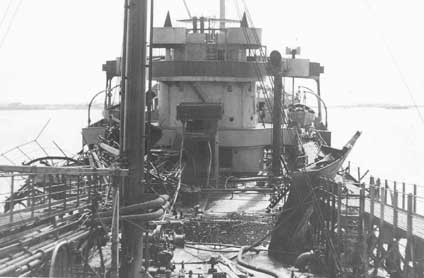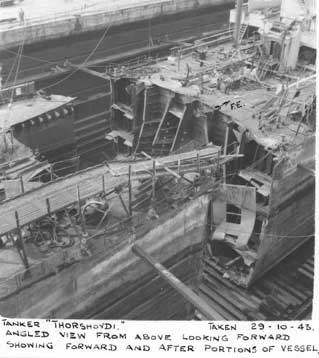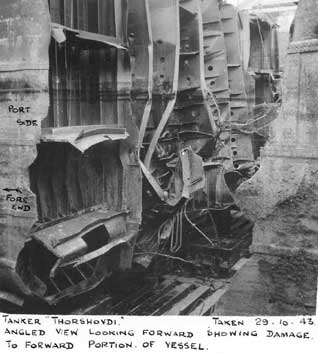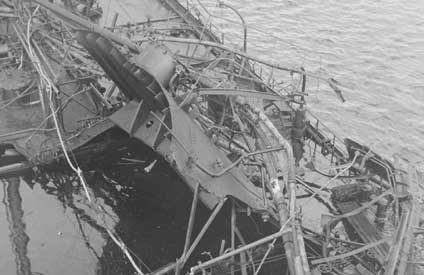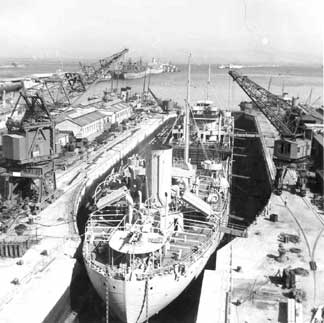| Site Map | Search Warsailors.com | |
|
M/T Thorshøvdi To Thorshøvdi on the "Ships starting with T" page. Owner: A/S Odd, Sandefjord Delivered in Sept.-1937 as Thorshøvdi from Deutsche Werft AG, Hamburg (172) to A/S Odd (A/S Thor Dahl), Sandefjord, having originally been ordered for Unilever Ltd., London, but sold to Thor Dahl in Dec.-1936. Captain: Arthur Svendsen In Admiralty service from 1940 (Royal Fleet auxiliary). Her voyages are listed on these original images from the Norwegian National Archives: Please compare the above voyages with Arnold Hague's Voyage Record below.
(Received from Don Kindell - His source: The late Arnold Hague's database). Follow the convoy links provided for more information on each. Errors may exist, and several voyages are missing.
As will be seen when going to Page 1 of the archive documents, Thorshøvdi was on her way from Bahrein to Hong Kong when war broke out in Norway on Apr. 9-1940. Her 1941 voyages also start on this document and it'll be noticed that she spent quite a long time in New York that year, before proceeding to Halifax on July 3. She was scheduled for Convoy HX 137 to the U.K. on July 6-1941, but instead joined the next convoy on July 11, HX 138, however, she returned to Halifax - according to A. Hague, she had been involved in a collision. Thorshøvdi later continued to New York, and it looks like she was repaired there; a report written by the captain of Daghild says that this ship took some cargo from Thorshøvdi because the latter had to go in for repairs after a collision in convoy - see my page about M/T Daghild. Thorshøvdi spent a long time in New York before returning to Halifax on Sept. 14, subsequently joining Convoy HX 151 on Sept. 22, along with the Norwegian Sama (station 85), San Andres (105), Meline (43), Morgenen (93), Belinda, Dagrun (54), Sophocles (left the convoy and sailed independently), Tigre (44), Hardanger (94), Leiv Eiriksson (24), and Laurits Swenson. Thorshøvdi had a cargo of fuel oil, sailing in station 53, and arrived Swansea, via Belfast Lough, on Oct. 8. A few days later, some of these ships, including Thorshøvdi, joined the westbound North Atlantic Convoy ON 26. Thorshøvdi was bound for New York, where she arrived Nov. 1, the convoy having been dispersed on Oct. 29. From New York, she continued to Aruba a couple of days later (Page 1), then headed to Halifax in order to join Convoy HX 161 back to the U.K. on Nov. 21. According to Robert Cressman, the escorting American destroyer DuPont (DD-152) was damaged in a collision with Thorshøvdi on Nov 24 (see relevant date at the link to "Hyperwar" below). Thorshøvdi returned to Halifax (arrived Nov. 28), leaving again on Dec. 3, joining Convoy HX 163, arriving Swansea Bay on Dec. 22. With Bello, Brasil, Kaia Knudsen, Katy, Morgenen, Mosli, Nyholt, Solsten, Stigstad, Tungsha and Vanja, she went back across the Atlantic at the end of that month with Convoy ON 52*, which originated in Liverpool on Dec. 31 and dispersed Jan. 11-1942. Montbretia and Rose are named among the escorts - see ON convoy escorts. Thorshøvdi's destination is not given, but from Page 2 of the archive documents, we learn that she arrived Mobile on Jan. 25, remaining there for almost a month. With a cargo of gas oil, she headed back to the U.K. again on March 9-1942 in Convoy HX 179 from Halifax, subsequently joining the westbound Convoy ON 81*, which originated in Liverpool on March 29 and dispersed Apr. 9 and also included Polarsol, Solsten and Thorshov (Commodore Vessel). Her destination is given as Corpus Christi, but she arrived Curacao on Apr. 17 (having started out from Fleetwood March 29). The following month, she's listed in Convoy SL 110, which originated in Freetown on May 13 and arrived Liverpool on June 4; Thorshøvdi arrived Greenock that day, cargo of 6544 tons marine fuel oil and 5503 tons heavy fuel oil, station 54; according to A. Hague, she had joined this convoy at sea from Trinidad on May 13 (Trinidad not mentioned on Page 2) - she had sailed from Curacao on May 4. The Norwegian Polarsol and Velma are also listed - see the external link provided within the Voyage Record above for more convoy information. About a week later we find her, along with Ferncourt, Frontenac, Garnes, Idefjord, Kaia Knudsen, Kong Haakon VII (Commodore Vessel), Lista, Maud, Mirlo, Noreg, Scebeli, Sommerstad, Tijuca and Troubadour, as well as the Panamanian Norvinn (Norwegian managers), in the westbound Convoy ON 103*, originating in Liverpool June 12. Thorshøvdi joined from Clyde and arrived New York on June 27, proceeding from there to Curacao, then back to New York and on to Halifax (convoy information for these voyages can be found in the table above). She's now mentioned in connection with the ships leaving Halifax to form Convoy HX 204 on Aug. 23, but she must have returned to port (or did not join) because she's also listed in HX 205 on Aug. 30, for which Acanthus, Eglantine, Montbretia and Potentilla are named among the escorts. Thorshøvdi arrived Clyde Sept. 11 and together with Abraham Lincoln (Commodore Vessel), Biscaya (from Halifax), Brasil, Ferncourt, Helgøy, Høegh Scout, Katy and Vardefjell, she subsequently returned with Convoy ON 131*, originating in Liverpool on Sept. 18, arriving New York Oct. 4 (she had again joined from Clyde). Having made another voyage to Curacao and back to New York (Page 2 - convoy info in the table above), she joined Convoy HX 218 on Dec. 5, bound for Clyde, station 54. Her last Trans-Atlantic voyage that year was made with the westbound Convoy ON 157 at the end of Dec.-1942, arriving New York Jan. 15-1943 (Skiensfjord acted as Commodore Vessel for this convoy). Thorshøvdi's voyages in this period are shown on Page 3. In Febr.-1943, she can be found in Convoy HX 226, bound for Scapa Flow, where she arrived Febr. 25 (Commodore in Laurits Swenson). In March that year, we find her in Convoy ON 172*, which left Liverpool on March 9 and arrived New York on the 27th (looks like Thorshøvdi joined from Londonderry; A. Hague says she served as Escort Oiler). Belinda, Fjordaas and Laurits Swenson are also listed, the latter again serving as Commodore Vessel. According to Arnold Hague, Thorshøvdi now returned in Convoy HX 232*, which left New York on Apr. 1 and arrived Liverpool Apr. 16; Thorshøvdi stopped at Clyde that day. Belinda, California Express, Heranger, Ørnefjell, Skandinavia, Thorhild, Tigre and Tungsha are also named in this convoy, which lost 4 ships - ref. external link below. The following month, she joined Convoy ON 182* (Escort Oiler), which originated in Liverpool on May 6 and arrived New York May 22 and also included Dageid, Fernwood, Gallia, Germa, Hiram, Ivaran, Oregon Express, Skiensfjord, Thorshov and Villanger. Thorshøvdi had sailed from Londonderry May 7 (Page 3). From New York, she headed to Gibraltar a few days later, with arrival there on June 16 (convoy info in Voyage Record). She left Gibraltar again on June 21 in order to go back to the U.S., but returned to Gibraltar.
Related external links:
At the beginning of Aug.-1943, she was at Gibraltar, with several other ships. On Aug. 3, she had received orders to move out from the Admiralty Harbour to another anchorage until sailing time, which was set to the early morning hours of Aug. 4. She had a cargo of 10 690 tons of Admiralty fuel oil (for North Africa?). By the evening of the 3rd she had anchored on the west side of the bay, about half a mile from the Spanish shore, as per orders received by the pilot. At the same time, a few kilometers further away at Algeciras, there was an old Italian cargo ship, Olterra, left behind when Italy joined the war in 1940, still with an Italian crew on board (see the external links at the end of this page). In all secrecy this ship had been converted to a base for frog men and manned torpedoes, a fact which was not at all visible in her rusty appearance. An equally innocent looking villa provided a full view of the activities in the harbour, and served as a lookout post (Villa Carmela). The Italians had already successfully sunk 3 ships on May 8, without the British suspecting the Olterra at all. So on Aug. 3, Ernest Notari with 3 manned torpedoes quietly slipped out the escape well at the bottom of Olterra, with Vittorio Cella and Eusebio Montalenti riding the torpedo that was meant for Thorshøvdi. They successfully attached their limpet mines to the bottom of the ship, then returned to the Olterra(?). Early in the morning, Aug. 4 the first ship exploded, the American Harrison Grey Otis, then Thorshøvdi, followed by a third explosion which sank the British Stanridge. A report about the incident presented at the subsequent inquiry says the explosion on Thorshøvdi occurred at 04:10. Fuel oil from the tanks were thrown up into the air and the ship went down in the middle by No. 6 center tank and very loud cracks could be heard. Fearing she would break in 2, orders were given to take to the lifeboats and remain close until daylight. Those who were amidships, inluding the captain, went into the port midships boat which was found to be filled with oil and water and was floating on the tanks. A large piece of iron had pierced the bottom of the lifeboat and had made a big hole. When a British Naval patrolboat came alongside 6 men were transferred to this vessel. The rest of the crew were in the other lifeboats from the aft of the ship. Fortunately, no lives were lost on Thorshøvdi, and later that morning her crew was taken back to the ship by a tug, whereupon she was towed away to the Gibraltar side of the bay where she was anchored in shallow water about noon. She was aground amidships, and all over the ship were pieces of iron plates, rivets and other wreckage that had been thrown up in the air by the explosion. She had had 59 depth charges on her afterdeck, some of which had disappeared, but whether they had exploded or fallen overboard was not known. No visible damages to the machinery had been found. On Aug. 5, a Lloyd's surveyor and a local representative of the Ministry of War Transport came on board to inspect the damages and to arrange for the discharging of the part of the cargo that could still be used. The crew was living on board at that time. An inquiry was held in Gibraltar on Aug. 15-1943 with the captain, the 1st engineer and the 2nd mate attending. It appears they already knew the cause of the explosions because a British Government diver had found clamps for securing wire to the bilge keels, and pieces of metal believed to be from "enemy bomb containers" had been found on deck. According to the captain's statements, the patrolboat that picked them up headed towards another vessel where a diver had just been sent down to examine the ship for limpet mines, and just as they reached it that ship also blew up (probably Stanridge), a piece of iron falling through the roof of the deck house and severely injuring the coxswain who was taken ashore by the patrolboat. Captain Svendsen adds that there was also an Italian on board who had been fished out of the water - perhaps this was one of the "culprits" who had not been able to get away before Stanridge exploded? Thorshøvid's foreship was towed to Bona, while the afterpart remained in Gibraltar. (Note that according to Page 3 of the archive documents, the stern part arrived Bona on Dec. 11-1945. She had been accepted by underwriters as total loss on Apr. 9-1945). Here is a series of pictures showing Thorshøvdi after this incident - all received from Narve Sørensen, Norway (this external website also has some pictures):
Crew List - No casualties:
Both parts were sold in March-1946 to Georg Vefling, Tønsberg, Norway and subsequently towed to Newcastle for repairs, entering service in Febr. 1947 as Giert Torgersen for Skibs-A/S Oiltank (Georg Vefling), Tønsberg, having become 9990 gt. Sold in June-1954 to A/S Tønsberg Hvalfangeri, Tønsberg and renamed Teie. In Nov.-1954 she was converted to transport tanker by Kieler Howaldtswerke AG, Kiel, becoming 11 342 gt. Sold in July-1960 to A/S Albion Star/Alfredo Ryan, Buenos Aires (managed by E. S. Martinsen, Sandefjord) and renamed Tota. Sold again in Jan.-1964 to Eriksbergs mek. Verkstads A/B, Gothenburg, Sweden and laid up there as accommodation vessel. Arrived Santander for breaking up on Sept. 3-1970. Related external links: Back to Thorshøvdi on the "Ships starting with T" page. Other ships by this name: Thor Dahl later had a whale factory (M/S) by this name, built 1948, sold to London 1966 (Drillship, Star I, Sonda I, J. W. Bates). This external site has lots of pictures of this ship, as well as more information (text is in Norwegian). The company also had a tanker by the name Thorshøvdi delivered to them in Sept.-1968, 54 477 gt. Later names: Eirama 1979 (owning company in the Bahamas - still managed by Thor Dahl), Miaoulis 1985 (Cyprus), Kountouriotis 1986, North Cape 1987 (Farsund, Norway). Had several different Norwegian owners before being broken up in 1992. The text on this page was compiled with the help of: "Nortraships flåte", J. R. Hegland, "The Allied Convoy System", Arnold Hague, "Sjøforklaringer fra 2. verdenskrig", Volume II, Norwegian Maritime Museum, and misc. (ref. My sources).
|
||||||||||||||||||||||||||||||||||||||||||||||||||||||||||||||||||||||||||||||||||||||||||||||||||||||||||||||||||||||||||||||||||||||||||||||||||||||||||||||||||||||||||||||||||||||||||||||||||||||||||||||||||||||||||||||||||||||||||||||||||||||||||||||||||||||||||||||||||||||||||||||||||||||||||||||||||||||||||||||||||||||||||||||||||||||||||||||||||||||||||||||||||||||||||||||||||||||||||||||||||||||||||||||||||||||||||||||||||||||||||||||||||||||||||||||||||||||||||||||||||||||||||||||||||||||||||||||||||||||||||

